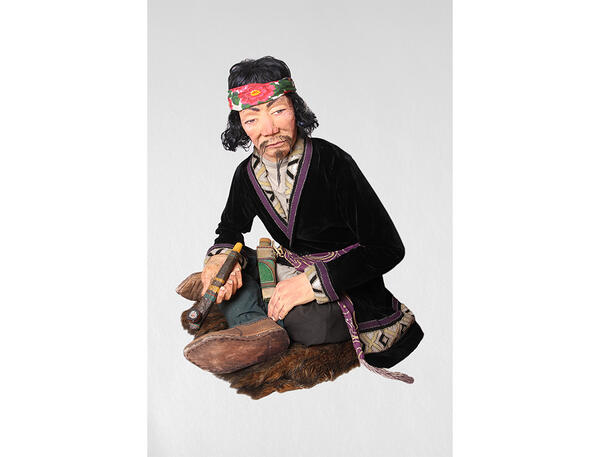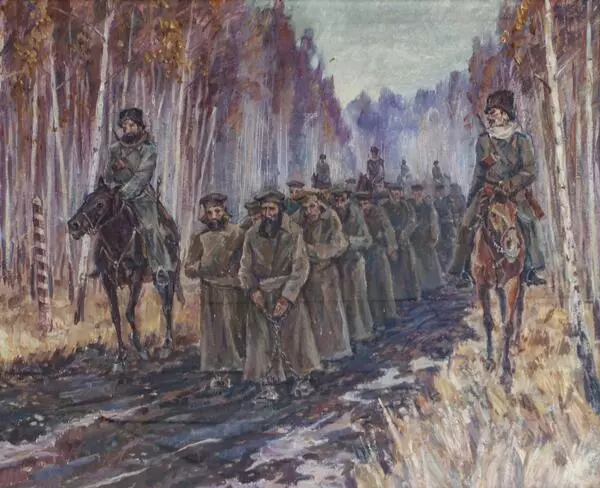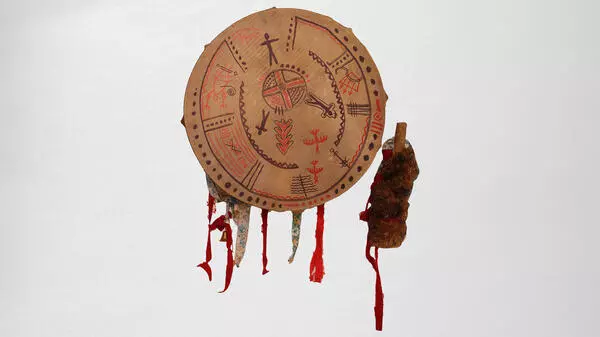The Selkup doll from the museum’s collection was created by the artist Yuri Mikhailov. The master sculpted the statuette from plaster, made clothes from fabric and paper, and painted the face with paints.
The Selkups are the people who live in the north of Western Siberia. They were first mentioned in written sources of the 16th century. The documents say that the head of the Selkup family was a man. He was engaged in trading. A woman was responsible for household chores and bringing up children.
The main occupations of these people were hunting, fishing and gathering. The Kiya river in Siberia, on the banks of which the Selkups settled, was full-flowing and was home to large fish. In the evenings, men built small rafts, lit a fire on a raft’s surface, and sailed them down the river. The fish attracted by the light would rise to the surface, and the Selkups would catch it with a fish spear — a tool shaped like a pitchfork.
The Selkups were skilled hunters. Their main weapon was a bow and arrows. They decorated their clothes with fur from fur-bearing animals, and made their traditional footwear — ichigy and mukluks — from roe deer skin.
The Selkups believed in forest and water spirits. They made sacrifices to obtain their support. The sacred places of the Selkup people were the Mountain of Spirits and the Spirit Lake, and they worshiped bears and elks as sacred animals. The Selkups made wooden idols in the form of these animals and worshiped them. Shamans played a special role in the Selkup settlement: they cured diseases, settled disputes, foretold the future and served as mediums between people and spirits.
The Selkups lived in chums. The portable chum with a diameter of eight–nine meters was built by covering the frame with tree poles, birch bark or skins. In summer, they put canopies against mosquitoes. In the center of the tent there was a fireplace on the ground, sometimes a fireplace with a chimney was installed so the smoke could come out through a special hole between the tops of the poles of the frame. The place opposite the entrance to the tent, behind the fireplace, was considered honorable and sacral. The floor was mostly earthen, or covered with planks to the right and left of the fireplace. The Selkups slept on skins or mats. Usually two families or married couples, such as parents with married children, lived in a chum.
The Selkups are the people who live in the north of Western Siberia. They were first mentioned in written sources of the 16th century. The documents say that the head of the Selkup family was a man. He was engaged in trading. A woman was responsible for household chores and bringing up children.
The main occupations of these people were hunting, fishing and gathering. The Kiya river in Siberia, on the banks of which the Selkups settled, was full-flowing and was home to large fish. In the evenings, men built small rafts, lit a fire on a raft’s surface, and sailed them down the river. The fish attracted by the light would rise to the surface, and the Selkups would catch it with a fish spear — a tool shaped like a pitchfork.
The Selkups were skilled hunters. Their main weapon was a bow and arrows. They decorated their clothes with fur from fur-bearing animals, and made their traditional footwear — ichigy and mukluks — from roe deer skin.
The Selkups believed in forest and water spirits. They made sacrifices to obtain their support. The sacred places of the Selkup people were the Mountain of Spirits and the Spirit Lake, and they worshiped bears and elks as sacred animals. The Selkups made wooden idols in the form of these animals and worshiped them. Shamans played a special role in the Selkup settlement: they cured diseases, settled disputes, foretold the future and served as mediums between people and spirits.
The Selkups lived in chums. The portable chum with a diameter of eight–nine meters was built by covering the frame with tree poles, birch bark or skins. In summer, they put canopies against mosquitoes. In the center of the tent there was a fireplace on the ground, sometimes a fireplace with a chimney was installed so the smoke could come out through a special hole between the tops of the poles of the frame. The place opposite the entrance to the tent, behind the fireplace, was considered honorable and sacral. The floor was mostly earthen, or covered with planks to the right and left of the fireplace. The Selkups slept on skins or mats. Usually two families or married couples, such as parents with married children, lived in a chum.






